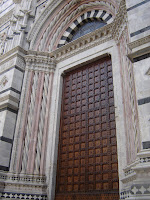 We park outside Siena and walk in through one of gates in the walls – Siena is a car-free city, being the first European city to banish motor traffic from its centre in 1966. Proceeding to Il Campo, we stock up with tourist information brochures and sit at a café at the edge of the square for a cappuccino and to get our bearings.
We park outside Siena and walk in through one of gates in the walls – Siena is a car-free city, being the first European city to banish motor traffic from its centre in 1966. Proceeding to Il Campo, we stock up with tourist information brochures and sit at a café at the edge of the square for a cappuccino and to get our bearings. Il Campo is scallop-shaped and slants on nine sections (for the members of the Council of Nine) from the Fonte Gaia (the Happy Fountain) to the Palazzo Comunale, which is sparse and elegant, dominated by the tower – the Torre del Mangia. The streets radiate in circles which swirl around and can make navigation difficult, but this hardly matters as it is pleasant to wander about the city admiring the buildings and sculptures.
Il Campo is scallop-shaped and slants on nine sections (for the members of the Council of Nine) from the Fonte Gaia (the Happy Fountain) to the Palazzo Comunale, which is sparse and elegant, dominated by the tower – the Torre del Mangia. The streets radiate in circles which swirl around and can make navigation difficult, but this hardly matters as it is pleasant to wander about the city admiring the buildings and sculptures. The cathedral is one of Italy’s greatest gothic churches – small in comparison with Florence’s but civic rivalry led Florence to try to do everything bigger and better.
The cathedral is one of Italy’s greatest gothic churches – small in comparison with Florence’s but civic rivalry led Florence to try to do everything bigger and better.
Legend states that Siena was founded by the son of Remus and so the symbol of the wolf feeding the twins Romulus and Remus is as ubiquitous as it is in Rome.
There are fountains and squares, palaces and churches everywhere but we don’t go into any of them – we just walk around the streets remembering to look up.
Every building has a coat of arms; a statue; a painted façade; a frescoed ceiling; ornate shutters; a tether for a horse; a decorative door, archway or window.

I get quite carried away with the doors and windows, and we have to buy a new memory stick for the camera to accommodate my happy snapping. Incidentally, camera shops share premises with opticians which I thought was a bit odd at first, but makes perfect sense really as they’re both concerned with lenses and visuals.

 Siena is a city of imaginings. Twice a year (2nd July and 16th August) it hosts Il Palio – a series of colourful pageants and a wild horse race around Il Campo. Ten horses and their bareback riders (representing the town’s districts) tear three times around the perimeter of Il Campo (it is covered with packed dirt) while the spectators are fenced into the centre.
Siena is a city of imaginings. Twice a year (2nd July and 16th August) it hosts Il Palio – a series of colourful pageants and a wild horse race around Il Campo. Ten horses and their bareback riders (representing the town’s districts) tear three times around the perimeter of Il Campo (it is covered with packed dirt) while the spectators are fenced into the centre.
I can imagine secret trysts and assignations in sun-drenched, high-walled courtyards where ancient frescoes look down on lovers whose murmurings are accompanied by the soft splash of fountains.

Siena still maintains its mediaeval gothic glory, leaving the flashy Renaissance to its Florentine rival, with whom it was frequently at war. It is allegedly the home of panforte – a rich cake of almonds, honey and candied fruit, which was created for Crusaders to take to the Holy Land – but we make do with enormous slices of pizza which we eat in the square.






No comments:
Post a Comment